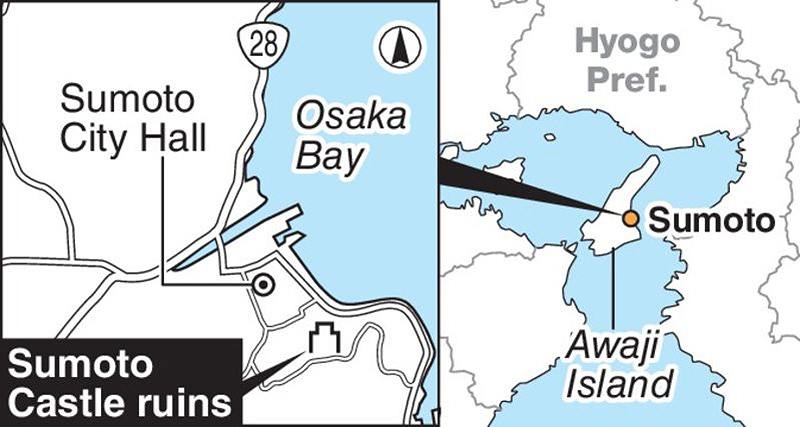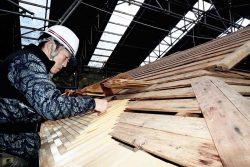
A symbolic castle tower stands above stone walls that partially collapsed due to heavy rain and are undergoing restoration, at the ruins of Sumoto Castle in Sumoto, Hyogo Prefecture.
December 4, 2021
SUMOTO, Hyogo — Old stone walls damaged by disasters and aging will be completely repaired at the ruins of a castle on Awaji Island.
Sumoto Castle is a mountain fortress built on top of Mt. Mikuma at an elevation of about 130 meters in Sumoto, Hyogo Prefecture. It was built by a warlord in the 16th century during the nation’s warring states period.
Most of the castle buildings were demolished by the 20th century after the end of the Tokugawa shogunate. What now stands on the top of the mountain is a symbolic castle tower built in the early 20th century to commemorate Emperor Showa’s ascension to the throne.
The concrete building is not a real castle tower based on historical facts, but the stone walls surrounding it are said to have been built between 1585 and 1609 and have great historical value.

Massive stones from the wall are seen scattered about the ruins.
Most of them were made of natural stones from Mt. Mikuma that were piled up to form a wall without cutting the stone or other processing. The castle ruins were designated as a national historic site in 1999. The remains, which stretch about 800 meters east to west, convey the romance of history to the present.
However, in addition to weathering over the years, the 1995 Great Hanshin Earthquake has loosened some parts and cracked some stones in the walls. In recent years, the area near the center part of the castle has been closed to the public due to the high risk of collapse.
The stone walls were scheduled to be taken apart this summer for repairs, but just before they could be, on Aug. 18, heavy rains collapsed the central part.
The Sumoto city government is working on a 10-year plan starting in April this year. The collapsed sections will be repaired in about two years, and other areas will also be improved, according to the plan.

Restoring a stone wall usually means carefully removing the stones one at a time and then putting them back after filling in the missing parts. However, parts of the piled-up rock walls at Sumoto Castle have collapsed and broken apart, which will force restoration staff to do more time-consuming work — they will have to fit the collapsed stones together like a puzzle while looking at photos taken before the collapse.
The basic restoration plan states dangerous areas will be repaired as soon as possible, and information boards and rest areas will also be installed. The disassembly of the stone walls will begin soon.
Metal plates have already been laid for heavy machinery to pass through, and scaffolding has been erected in preparation for the restoration work. The grass in the area has been cut as well, improving the view.
Related Tags
"Features" POPULAR ARTICLE
-

Students Recreate 19th-Century Bento Boxes Made for Ino Tadataka’s Survey Team in Hot Spring Town on Nakasendo Road
-

Santa Claus Delivers Christmas Presents to Penguins at Aquarium in Japan’s Nagasaki Prefecture
-

Sumo Restaurant in Tokyo Teaches Foreign Visitors About the Ancient Sport, with Bouts Between Retired Rikishi
-

Autonomous Passenger Ship Connects Mainland with Remote Island in Seto Inland Sea; World’s 1st Commercially Operated Autonomous Vessel
-

Osaka’s Sumiyoshi Taisha Shrine Bustles with New Year’s Visitors
JN ACCESS RANKING
-

As Chinese Tourists Shun Japan, Hotels and Stores Suffer
-

Osaka-Kansai Expo’s Economic Impact Estimated at ¥3.6 Trillion, Takes Actual Visitor Numbers into Account
-

Japan Govt Adopts Measures to Curb Mega Solar Power Plant Projects Amid Environmental Concerns
-

BOJ Gov. Ueda: Highly Likely Mechanism for Rising Wages, Prices Will Be Maintained
-

Economic Security Panels Debate Supply Chains, Rare Earths; Participants Emphasize Importance of Cooperation Among Allies



























